#i think the smaller scale of a murder mystery would be easier and more fun
Explore tagged Tumblr posts
Text
CoC Idea/Prompt #41 : Reasonable Doubt
Someone is dead, and you are responsible.
They were important. A celebrity. A community figure. The specifics don't matter.
What matters is that the police will be putting every resource into the investigation, into catching you.
So cover up the killing as best you can, evidence, witnesses, and alibis. How long can you outsmart the law?
#cthulhu#call of cthulhu#coc#cthulhu rpg#horror#rpg#ttrpg#my stuff#rpg ideas#ttrpg ideas#ttrpg adventure#cthulhu adventure#could do this as like a cop show type thing#or a murder mystery kinda sherlock thing#i think the smaller scale of a murder mystery would be easier and more fun
3 notes
·
View notes
Text
HI!!!
I'm currently working on a new short project as a way to take a sorta-break from Introdemo and explore different storytelling formats. It's a Homestuck fan adventure with Discolike characteristics.
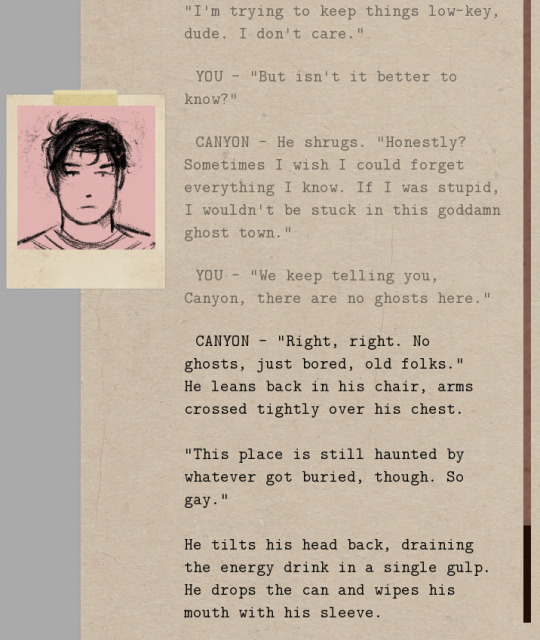
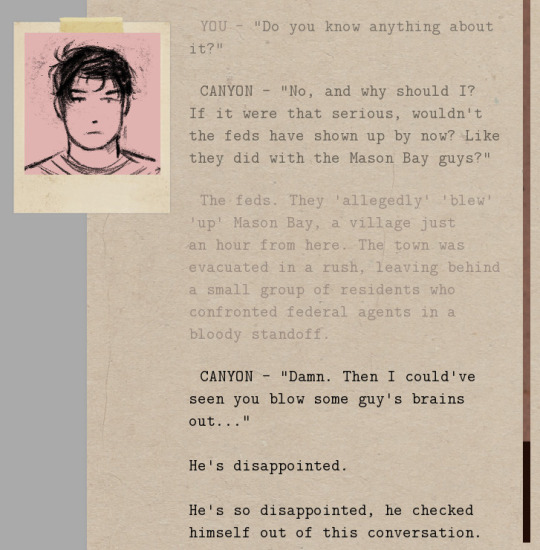
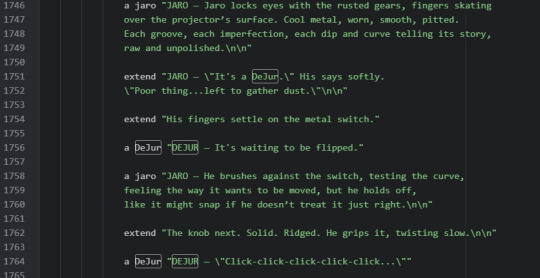
Progress on this project has been moving at a fast pace. I intentionally wrote it as a short story and set strict limitations for myself to keep it focused and concise. Tonally, it's very different than Introdemo. It's somber. Foggy. Gray. It's about a young woman in the fading town of Elowen who begins to unravel the forgotten truths of its haunted past, only to find that some secrets are better left buried.
Also, I accidentally recreated Fennel and Bailey. Kinda.
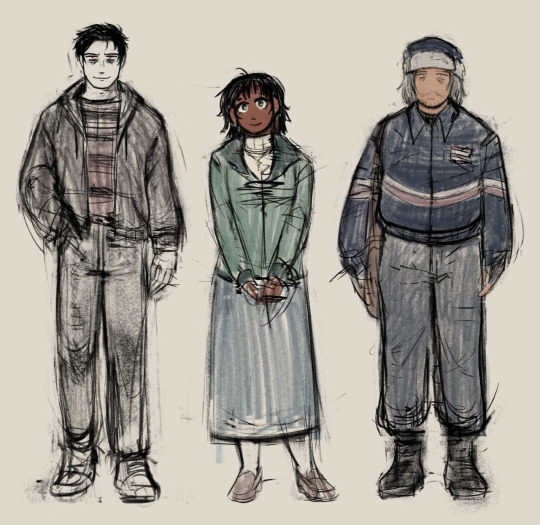
(fun fact: I'm recycling my Fallout protags for this story)

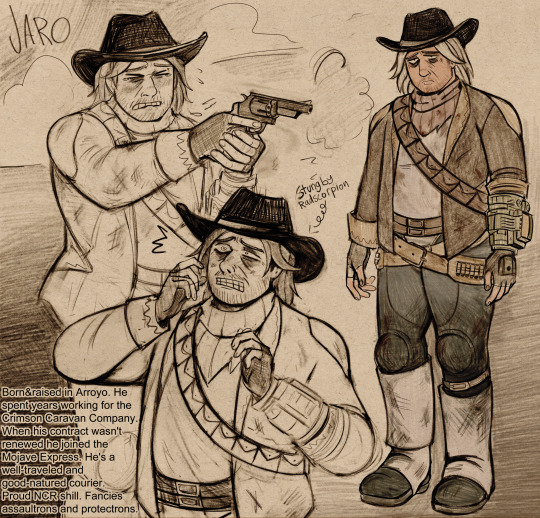
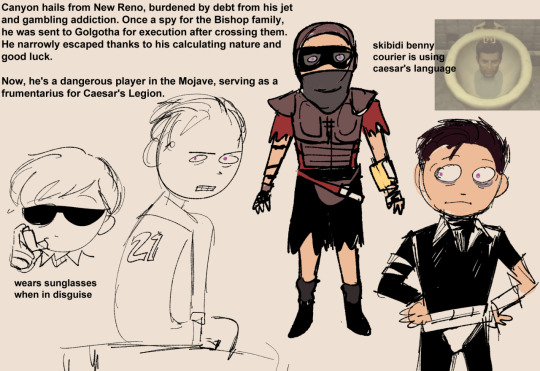
ANYWAYS. LET'S TALK ABOUT INTRODEMO.
I want to be transparent about the upcoming story changes for Introdemo so that no one is caught off guard when I release the demo again for the third or fourth time. While I initially said the story would stay the same, as I continued writing, it became clear that wasn't the case. I don't want to be working on this forever, so I've made some tough decisions.
I realized that I'm much more invested in the demon and contract storyline, and that's now the main focus. The most significant change is the removal of the murder mystery plotline. The serial SLAYer storyline will still play a crucial role (it's what kicks off the plot, after all!), though it won’t be the central focus anymore. Clyde and Fennel won't be focused on hunting them down. There's no time to play cops. They have a show to put on. And a show...they will put on!!!
Some characters are either being removed or having their roles scaled back. Fridge is gone for good (BYEEEE), while Val and Pine will have smaller roles. They weren't contributing meaningfully to the overall story, and with a smaller cast, the narrative feels easier to manage. Yua, on the other hand, will be brought more to the forefront, though she doesn't have a physical presence in the story’s present timeline.
I've mentioned this plenty of times before, but the love triangle is also gone. It was between Clyde, Darcy, and Diya. Now, it's just between Clyde and Diya (funny joke, Clyde, and, and Diya).
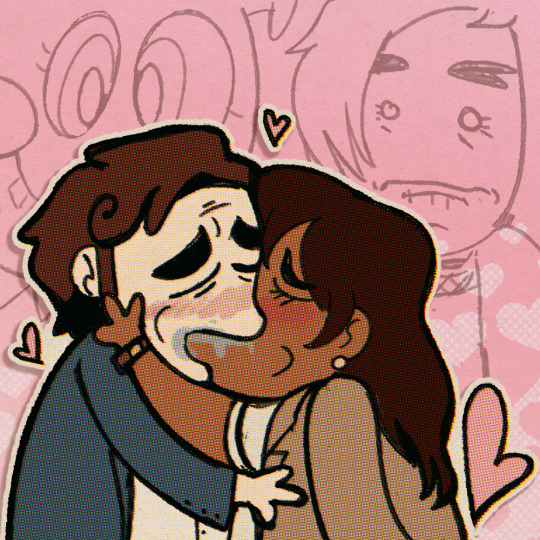
I don't want the romance to overshadow the plot. Instead, it's there to explore character dynamics and add tension. Yua's inclusion has the same purpose. I like to think of Bailey and Yua as the angel and devil on Fennel’s shoulders, respectively.
Also, I originally planned for the story to take place over the extended weekend (Thurs-Sun), but with the murder mystery plot now gone, it will take place over one very long day instead. I think this gives the story more urgency, especially towards the climax and end.
The POV changes will stay. I think you guys will REALLY enjoy Clyde's perspective... :-)
#sorry if i missed or mistyped anything im too lazy to proof read this#devlog#game talk#game development#game dev#game update#visual novel#ren'py#renpy#get me in search naooooo#introdemo
21 notes
·
View notes
Text
Why Do So Many People Love SAO? The Art of Mass Appeal
Hey! It’s okay! You are allowed to like Sword Art Online. I feel like I needed to explain that before somebody gets the wrong idea and thinks this is just me saying, “I don’t understand how somebody likes an anime that I don’t like!”
I just want to put this on the record: You’re not a bad person for liking SAO. You don’t have shit taste, and you���re not stupid. There are plenty of legitimate reasons to like this show, and, for this review, we’re going to be exploring what those reasons are because any show that can reach over a million people has to be doing something right.
No, this isn’t going to boil down to an insulting and reductive conclusion, like, “Thirsty weebs need wish fulfillment,” although I do think that is part of it for some people. This is a serious, analytical look at the series. The mechanics of mass appeal have always fascinated me, and SAO’s lacking qualities in other departments make it easier to isolate those mechanics than it would be looking at something like FMA.
You really can’t understate the impact that SAO has had on popular culture. It takes a lot of brand recognition for an American product to get a shot on network television, let alone a Japanese one. Much as critics like to downplay popularity as a measure of quality, success like that doesn’t just come down to random luck.
That said, luck is a major factor. SAO is often lauded for its great premise, but that’s only half the story. The most obvious factor in SAO’s whirlwind success is that it hit on the right premise, at the right time. When SAO came out in 2012, eSports and Free-to-Play games were becoming huge in the public eye. League of Legends had overtaken WoW as the most-played PC game of the year, and WoW’s death grip on the MMO market had loosened enough so that the landscape of online worlds was becoming more expansive and varied than it had ever been before. It was the perfect time to release any story about hardcore gaming, hardcore MMO gaming in particular, and with the Hunger Games phenomenon just starting to “catch fire” thanks to the first movie’s release, the market was hot for death game stories in particular. Add to that the exploding popularity of the then-new Game of Thrones and Walking Dead, and any series with a similar sense of lethality was bound to do well. Just look at how many articles at the time compare Attack on Titan and SAO to those two shows.
On top of that, anime was about to blow up in a big way in the West. Crunchyroll came to my attention in Fall of 2011, when they acquired the rights to Fate/Zero. I was hooked enough on the series from watching it on their ad-supported site to bite the bullet on a subscription just to get one episode ahead, and I don’t think I’m the only one. From 2011 to 2012, Crunchyroll began offering a serious value proposition by doubling their seasonal anime library, and becoming the go-to place for basically everything coming out of Japan by the Summer of 2012. It might not have been Fate/Zero specifically, but between huge series like HunterxHunter and quality niche stuff like Space Brothers and Kids on the Slope, the streaming service finally had enough content to pull in and sustain a hundred thousand subscribers by September of 2012, and two hundred thousand by March of 2013. Crunchyroll had become the service of choice for the then-niche community. SAO hit right in the middle of the surge in anime’s Western popularity, right at the point when Crunchyroll had enough content to be worth a subscription, but before it became totally unreasonable to watch everything on the service.
As one of the biggest fish in a rapidly-expanding pond, SAO both benefited from and helped spur on the service’s growth. Since it was one of the most popular shows on the service, Crunchyroll naturally put it at the forefront of their marketing push, which only increased its brand caché among anime fans and casuals alike. At this point, SAO was huge in Japan, and within the niche of Western anime fandom. It had proved its market viability enough to become a flagship title for the recently revived and redesigned Toonami block on Cartoon Network in Spring of 2013, and it was both relevant and popular enough to be added to Netflix in 2014, right in time to hype up the second season.
Anime had become a massive wave, washing over popular culture. Like 2013’s Attack on Titan, SAO had the good fortune to start riding that wave while it was still small, and go all the way to the top. The two series’ similar tone, and similar lethality, meant that fans of one were likely the fans of the other, and the cross-pollination only helped them both.
However, if good timing and an enticing premise were all it took for a show to embed itself in the popular culture, we’d be staring down Season 3 of The Unlimited Hyoubu Kyousuke right now. As much as it pains me to admit it, SAO does do some things very right when it comes to its execution that primed it for its whirlwind success. One of the biggest factors in this regard is the look of the show. A1 Pictures has faced a lot of criticisms from anime YouTubers and critics in general for the uniform look of its productions, and indeed, it can get pretty tiring to see the same faces, in nearly identical art styles, over and over again. However, that’s not going to be a problem for the casual anime fan, whose only seen a few dozen series. Their shows might look pretty similar, but they all look polished and professional, assuming they’re given enough time in production. They might not look or feel as nice as something from Ufotable, Kyoto Animation, or Bones, but they can get most of the way there in less time with a smaller budget, and that’s impressive. People like things that feel polished and professional.
If you haven’t seen a million shows like it before, SAO looks really clean and cohesive. It looks like what you expect a good anime to look like. The lineart is sharp and crisp, the characters blend with the environments well (at least, when the characters aren’t moving), and you can freeze on almost any frame and use it as a pretty decent wallpaper, which is all that many casual anime fans look for in a show’s visuals.
A1’s visual style is also very versatile. Its characters look cool, but they’re still very expressive. The girls can be moe cute, the heroes can look badass and youthful, and the adults can look old and hardened, and they all exist within the same world. Despite its “same-face syndrome” problem when put next to other A1 anime, SAO’s main cast has impressively diverse and easily recognizable character designs.
On the subject of design, while I do think that SAO would be a crappy game in real life, I will credit it for looking very visually appealing. The environments are super varied and interesting, from the flower dungeon, to the ice peak where they fight the dragon, to the trippy cave system where they find the Gleam Eyes. As VR spectacles go, this world would be a hell of a draw. The show’s visuals can really pop with vibrant colors, without looking too silly, and those can be muted down for more serious scenes without it looking incongruous with the rest of the show. SAO manages to sell moe, horror, action, and even Looney Tunes-esque cartoon comedy at times, and it all feels like roughly part of the same series.
That highlights one of the show’s other big strengths: plot variety. Because of the longtime scale of its storyline and the way that its setting creates a sort of blank slate for adventure, it can dabble in lots of different plot concepts, and even genres. One episode might be a short tragedy about Kirito watching all of his friends die, while the next is a cute story about saving a little girl’s pet and beating up some cackling Team Rocket villains, and that can be followed with a two-parter murder mystery, and after that, why not, let’s go on a side quest for crafting materials that blossoms into a short unrequited love story.
None of these individual stories have to be particularly great, hell, they don’t even have to make much logical sense because each one is so different from the last that it’s kind of fun to watch just for the surprise of finding out what they’re going to do next. Even if you really hate one storyline, you can rest assured that something new is on the horizon within an episode or two, and there’s a good chance that at least one of the many things the show tries will work for you.
Because Kirito’s character arc is about learning to open up to other people, all of those different plots feel like they’re moving the central plot forward, or at least a little, even if they’re really just filler. That results in a show that feels like it’s moving forward at a good pace. Emphasis on “feels” because if you look at the actual storytelling and logical structure of events, it’s an absolute mess. Just look at the final fight between Kirito and Kayaba Akihiko, it just comes out of nowhere on Floor 75 and it doesn’t work at all. However, if you’re just sitting down for entertainment, how a show feels to watch is paramount, and what sense it makes doesn’t matter so much.
Just to be clear, I’m not saying that it’s dumb to enjoy a show on that level. There’s value in sitting down, turning your brain off, and simply being entertained for the sake of relaxation. Analyzing anime can feel like work. For some, it is work. In SAO, it feels like at least one really important thing happens every single episode, and there’s usually a really cool-feeling action scene every two or three episodes to keep the excitement up. As a result, the show has momentum. Once you start watching, it’s very easy to keep watching without getting bored or confused. The show is consumable, like popcorn or other A1 Pictures shows like Gate.
The show suffers, a lot, when it loses this forward momentum, which I think is a big part of why even fans of the series acknowledge that the Fairy Dance arc kinda sucks. Kirito has a clear goal there, with an obvious solution in trying to rescue Asuna, which means that any diversion from that goal, like going off to fight a random guy in PvP, feels like a true waste of time. Furthermore, Kirito’s character is entirely static during that storyline. He doesn’t grow or change at all. Neither does Asuna, nor anyone aside from Suguha, and even then, only kind of. Therefore, even when the story is moving forward, it feels kind of flat.
Gun Gale fixes this problem in a kind of artificial way of giving Kirito sudden onset PTSD to get over, but it does help the story feel more substantial, and fans reacted positively to that. When it does work, even if it doesn’t actually have any idea where it’s going, SAO’s story moves forward with a bold sense of confidence and purpose.
Speaking of boldness, SAO also excels at setting a strong tone for whatever is happening in its story at any given time, particularly early on. Not necessarily the most appropriate tone, but a tone that is powerful and striking nonetheless. The monsters feel scary and intimidating, the comedy feels fun and lighthearted, the romance feels heartwarming and intimate, and deaths feel tragic and poignant. If you’re not invested in the story and characters, a lot of this can feel cloying and emotionally manipulative, but until something happens to take you out of that (like Yui’s death did for me), watching SAO is an emotional rollercoaster.
A big part of that is Tomohiko Ito’s direction. He is really good at placing the camera and cutting in a way that draws out the maximum possible emotion from any given scene. He needs to work with great source material, like Erased or Gin no Saji to really shine, but even working with Reki Kawahara’s leavings, he does a good job. The use of reflections in windows while Kirito listens to Sachi’s last message to him is legitimately incredible filmmaking.
The emotional impact of the series is further enhanced by the work of Yuki Kajiura, Tomohiko Ito’s most favorite composer, who also crafted the amazing soundtrack of Erased, as well as Tsubasa, Madoka Magica, Fate/Zero, Kara no Kyoukai, and some of the Xenosaga video games. Yuki Kajiura is one the most singularly talented composers working in the anime industry today, and it’s hard to understate just how much of an impact I think she’s had on the perceived quality of SAO. Her compositions for the show give it an air of cinematic quality, but they also feel distinctly, and very appropriately, video game-y. In particular, I’d argue that she is the primary reason that people say SAO has good action scenes. Her compositions make fights that are actually pretty stilted and janky, outside of a few sakuga cuts, feel incredibly bombastic and slick. When SAO’s music kicks up, it gets your pulse pounding, and it’s hard to resist getting caught up in it or even humming along to that memorable hook. Watch these fights without the music, and they kinda suck.
Kajiura’s abilities don’t just improve the action scenes, though. Her work is an integral part of that emotional roller coaster effect, heightening the emotion of each scene and connecting the emotional beats so that the shifts in tone feel less jarring than they might otherwise feel. She makes the scary scenes feel scary, the sad scenes feel much, much sadder, and the romantic scenes feel powerful and moving. That brings us to the big reason that I think people love SAO.
Most of the things I’ve talked about so far aren’t totally unique to SAO, and though they are important factors in getting people interested and keeping them invested in what’s going on, they’re not enough on their own to make people care so much that they’ll tell me to kill myself when I badmouth it. To evoke that kind of emotional response, a show really needs to get its audience to say, “Fuck yeah!”
The thing that makes a lot of people say that, myself included when I first watched SAO, is the fact that Kirito and Asuna get together in Episode 10, after several episodes of buildup where other characters notice they have a thing for each other, and it’s just really cute. That’s just not a thing that happens in anime. Even in shows with a clear OTP relationship, nine times out of ten the romance will be drawn out to its breaking point, and the characters will only hook up right at the end of the story, which isn’t just a lazy way to create an emotional arc, it’s tedious to watch.
The “will they, won’t they” is a story we’ve seen a million times, while the equally interesting story about what happens after, the trials and tribulations of actually dating and being in love, is almost never touched upon. You can justify that in a romance anime where the story is about characters sorting out their feelings and finally getting together (Toradora does that and it’s just about perfect), but even there, after a while you start to crave shows that buck that trend, like Ore Monogatari, My Little Monster, and Golden Time.
Also, with shows that have other things driving the plot, there’s really no excuse. There are few things that could really improve on Fullmetal Alchemist, but Winry and Ed hooking up earlier in the story would probably be one of them. Look at how many people loved Mikasa’s confession to Eren at the end of Attack on Titan Season 2. That was beautiful!
It’s a very pleasant surprise to see two main characters of a show like SAO commit to a monogamous relationship this early in the plot, and I think that most people who love the series do so because, in this respect, it doesn’t waste their time. This plot turn changes a lot of story dynamics, too, since Kirito and Asuna can be explicitly motivated by their love for one another, and that love can be made much deeper than the obvious mutual crushes that drive shows less willing to pull that trigger. For a story so driven by its emotional content, that one change makes SAO feel very different from just about everything else a casual fan is likely to have seen, and from what you would probably expect going into the show.
Now if you’re like me, and you think a lot about story structure and plot logic, that effect of that change doesn’t really last. Reki Kawahara is totally unwilling to abandon his harem anime nonsense, so every arc sees Kirito introduced to a new hot girl who wants to jump his bones. In terms of narrative structure, that really undercuts the importance of his commitment to Asuna.
However, if you’re just watching the show to enjoy a show, then it feels very substantial, to the point that fans get very mad at me when I call this harem anime a harem anime, in the same way that all of the deaths early on make the show feel very lethal and dangerous, so long as you don’t realize that all of the key characters have plot armor. If you do buy into it, the scenes of Kirito and Asuna being a couple and enjoying each other’s company are extremely emotionally satisfying. By the same token, if Yui doesn’t bug you the same way she bugs me, her relationship with Kirito and Asuna is adorable. Hell, Asuna and Kirito’s romance is the only part of the movie that I think really works. To get more cynical for a moment, for the segment of the audience that does use this show as pure escapist wish fulfillment, the fact that Kirito can have an emotionally fulfilling relationship with his wife, while still being chased by hotties all because he’s so dang good at video games that he’s basically invincible, those aspects only improve the show for you.
However, I don’t think that most people who love SAO love it for those reasons. I think they love it because it managed to get them deeply invested in its main characters through one very bold plot turn, and once you care about those characters, seeing Kirito be an unstoppable badass stops being eye-rolling, and starts being cool and fun. I think they love SAO because the world that it creates seems like a very appealing place on the surface to spend time in, and you can imagine yourself being one of the NPCs going off and doing something that’s not vital to Kirito’s plotline, like that guy who’s fishing, for some reason. I think they love SAO because it came at the right time in their lives, right when they were getting into anime. If you’ve seen hundreds of anime, then yeah, parts of it are going to feel played out, but if you’ve seen just a handful, SAO is going to feel fresh, and new, and exciting.
Considering that it’s at the forefront of the anime fandom, even today, I think it will be among many people’s first anime for many years to come, and I think that ties into why so many of us so passionately hate this show as well. Because when we discovered it, it had all of this promise and potential, but at one point or another, be it a poorly-executed death or a very, very poorly-executed rape scene, it let us down profoundly, and we were left unable to enjoy this thing that, at one point, seemed like it could be so great, that was, at one point, so enjoyable for us. That disappointment is a lot more cutting than the overt and unsurprising terribleness of something like The Asterisk War or Akashic Record.
But not everyone was disappointed in it in the same way. While I do think it’s fundamentally poorly made, SAO does some things right that are going to be more important for some people than the things it does wrong are for me.
0 notes